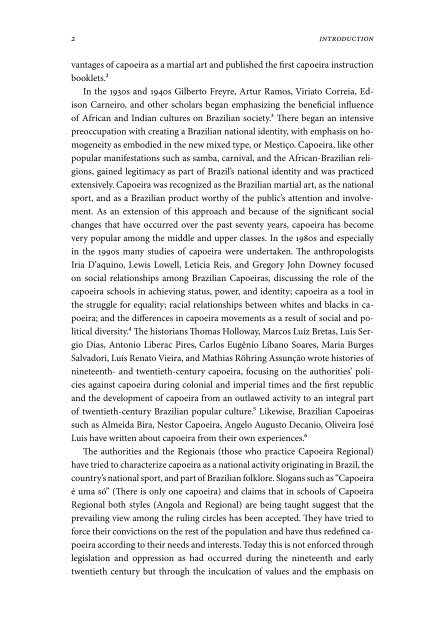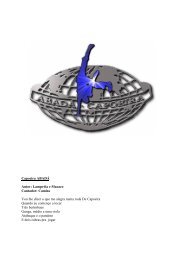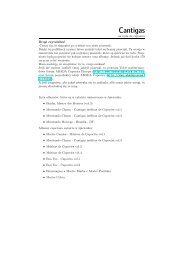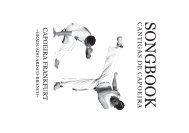A Collision of Cultures in the Brazilian Battle Dance - Capoeira Music
A Collision of Cultures in the Brazilian Battle Dance - Capoeira Music
A Collision of Cultures in the Brazilian Battle Dance - Capoeira Music
Create successful ePaper yourself
Turn your PDF publications into a flip-book with our unique Google optimized e-Paper software.
IntroductIon<br />
vantages <strong>of</strong> capoeira as a martial art and published <strong>the</strong> first capoeira <strong>in</strong>struction<br />
booklets.2<br />
<strong>in</strong> <strong>the</strong> 1930s and 1940s Gilberto freyre, artur ramos, Viriato Correia, edison<br />
Carneiro, and o<strong>the</strong>r scholars began emphasiz<strong>in</strong>g <strong>the</strong> beneficial <strong>in</strong>fluence<br />
<strong>of</strong> african and <strong>in</strong>dian cultures on <strong>Brazilian</strong> society.3 There began an <strong>in</strong>tensive<br />
preoccupation with creat<strong>in</strong>g a <strong>Brazilian</strong> national identity, with emphasis on homogeneity<br />
as embodied <strong>in</strong> <strong>the</strong> new mixed type, or Mestiço. <strong>Capoeira</strong>, like o<strong>the</strong>r<br />
popular manifestations such as samba, carnival, and <strong>the</strong> african-<strong>Brazilian</strong> religions,<br />
ga<strong>in</strong>ed legitimacy as part <strong>of</strong> Brazil’s national identity and was practiced<br />
extensively. <strong>Capoeira</strong> was recognized as <strong>the</strong> <strong>Brazilian</strong> martial art, as <strong>the</strong> national<br />
sport, and as a <strong>Brazilian</strong> product worthy <strong>of</strong> <strong>the</strong> public’s attention and <strong>in</strong>volvement.<br />
as an extension <strong>of</strong> this approach and because <strong>of</strong> <strong>the</strong> significant social<br />
changes that have occurred over <strong>the</strong> past seventy years, capoeira has become<br />
very popular among <strong>the</strong> middle and upper classes. <strong>in</strong> <strong>the</strong> 1980s and especially<br />
<strong>in</strong> <strong>the</strong> 1990s many studies <strong>of</strong> capoeira were undertaken. The anthropologists<br />
iria d’aqu<strong>in</strong>o, Lewis Lowell, Leticia reis, and Gregory John downey focused<br />
on social relationships among <strong>Brazilian</strong> <strong>Capoeira</strong>s, discuss<strong>in</strong>g <strong>the</strong> role <strong>of</strong> <strong>the</strong><br />
capoeira schools <strong>in</strong> achiev<strong>in</strong>g status, power, and identity; capoeira as a tool <strong>in</strong><br />
<strong>the</strong> struggle for equality; racial relationships between whites and blacks <strong>in</strong> capoeira;<br />
and <strong>the</strong> differences <strong>in</strong> capoeira movements as a result <strong>of</strong> social and political<br />
diversity.4 The historians Thomas Holloway, Marcos Luíz Bretas, Luis sergio<br />
dias, antonio Liberac pires, Carlos eugênio Líbano soares, Maria Burges<br />
salvadori, Luís renato Vieira, and Mathias röhr<strong>in</strong>g assunção wrote histories <strong>of</strong><br />
n<strong>in</strong>eteenth- and twentieth-century capoeira, focus<strong>in</strong>g on <strong>the</strong> authorities’ policies<br />
aga<strong>in</strong>st capoeira dur<strong>in</strong>g colonial and imperial times and <strong>the</strong> first republic<br />
and <strong>the</strong> development <strong>of</strong> capoeira from an outlawed activity to an <strong>in</strong>tegral part<br />
<strong>of</strong> twentieth-century <strong>Brazilian</strong> popular culture.5 Likewise, <strong>Brazilian</strong> <strong>Capoeira</strong>s<br />
such as almeida Bira, nestor <strong>Capoeira</strong>, angelo augusto decanio, oliveira José<br />
Luis have written about capoeira from <strong>the</strong>ir own experiences.6<br />
The authorities and <strong>the</strong> regionais (those who practice <strong>Capoeira</strong> regional)<br />
have tried to characterize capoeira as a national activity orig<strong>in</strong>at<strong>in</strong>g <strong>in</strong> Brazil, <strong>the</strong><br />
country’s national sport, and part <strong>of</strong> <strong>Brazilian</strong> folklore. slogans such as “<strong>Capoeira</strong><br />
é uma só” (There is only one capoeira) and claims that <strong>in</strong> schools <strong>of</strong> <strong>Capoeira</strong><br />
regional both styles (angola and regional) are be<strong>in</strong>g taught suggest that <strong>the</strong><br />
prevail<strong>in</strong>g view among <strong>the</strong> rul<strong>in</strong>g circles has been accepted. They have tried to<br />
force <strong>the</strong>ir convictions on <strong>the</strong> rest <strong>of</strong> <strong>the</strong> population and have thus redef<strong>in</strong>ed capoeira<br />
accord<strong>in</strong>g to <strong>the</strong>ir needs and <strong>in</strong>terests. today this is not enforced through<br />
legislation and oppression as had occurred dur<strong>in</strong>g <strong>the</strong> n<strong>in</strong>eteenth and early<br />
twentieth century but through <strong>the</strong> <strong>in</strong>culcation <strong>of</strong> values and <strong>the</strong> emphasis on






